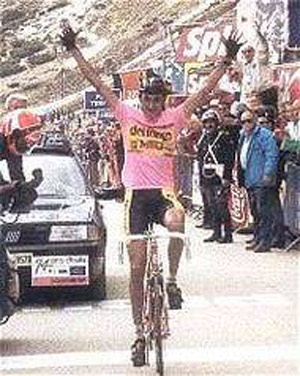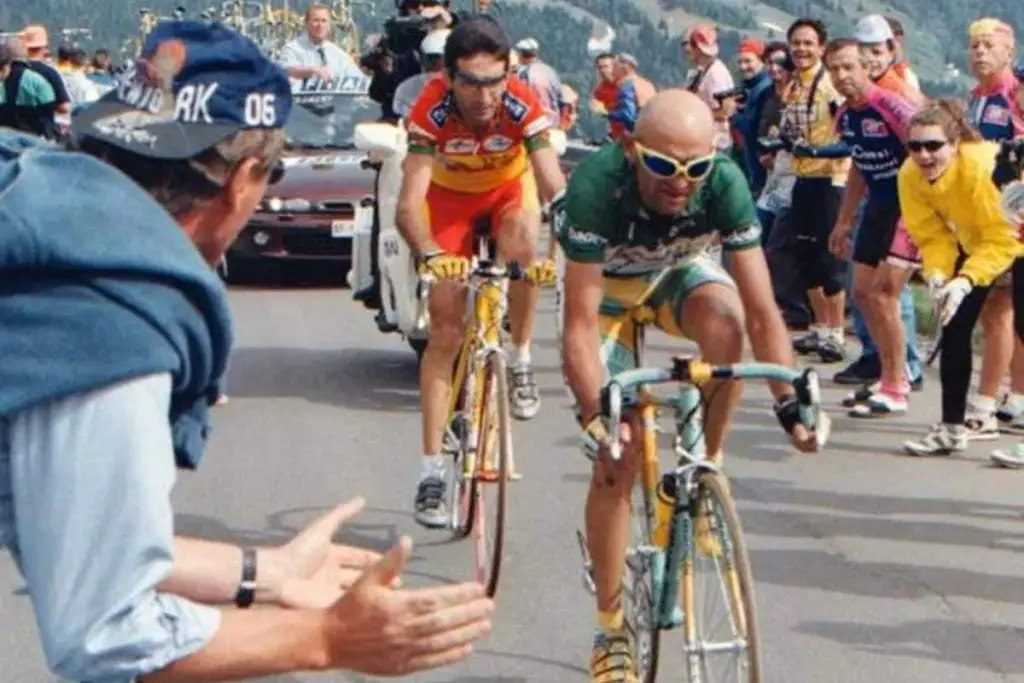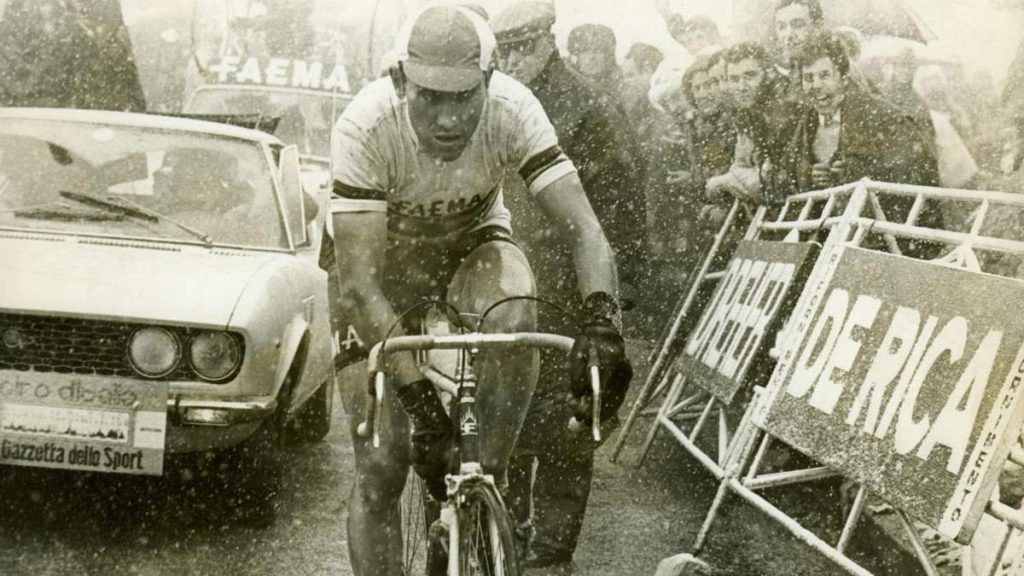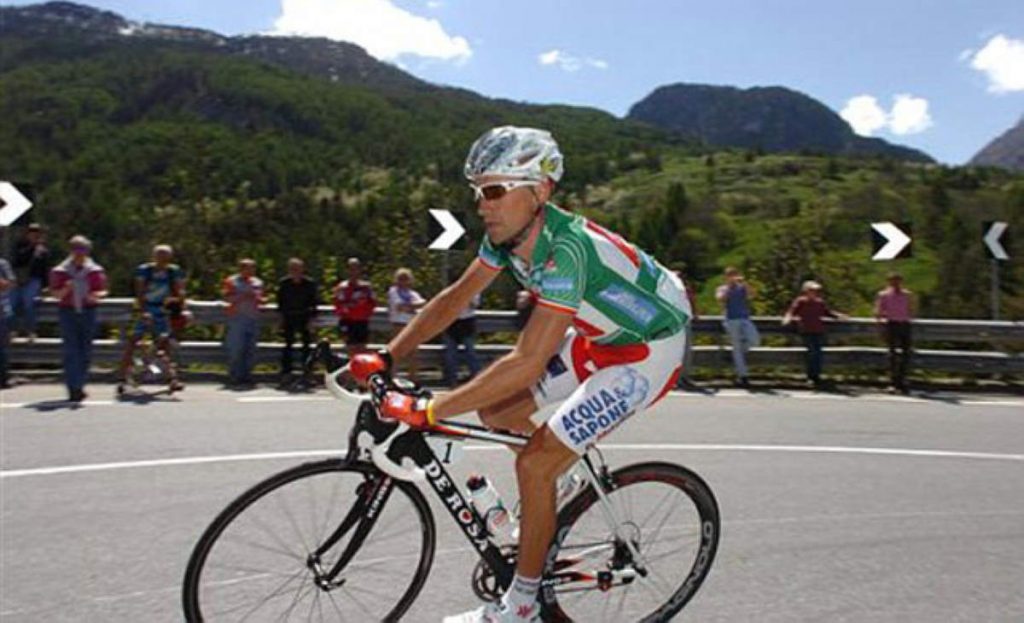Cima Coppi history – the Cima Coppi is the summit with the highest altitude reached by cyclists during the Giro d’Italia. It was established in 1965, five years after the death of the “Il Campionissimo” (champion of champions) Fausto Coppi.
Here is the brief history of Cima Coppi between 1990 and 1999.
Cima Coppi History (1990-1999), Year by Year
1990: Passo Pordoi (2,239 m / 7,346 ft), 1st pass: Maurizio Vandelli (Italy), 2nd pass: Charly Mottet (France)
Stage 16 featured six major ascents: Valparola, Gardena, Sella, Pordoi, Marmolada and again Pordoi. The Italian rider Maurizio Vandelli (Gis Gelati-Benotto) was the first atop Pordoi at the 1st pass. Then, on Marmolada, Charly Mottet, the French rider of the RMO team attacked. He took the eventual GC winner Gianni Bugno (Chateau d’Ax-Salotti) with him. Bugno was untouchable at this Giro. The duo worked together at the second ascent of Pordoi and Bugno gifted the stage to the Frenchman.
Mottet finished this giro in second, 6 min 33 sec behind Bugno. Vandelli finished in 22nd, 40 min 48 sec down.
1991: Passo Pordoi (2,239 m / 7,346 ft), 1st pass: Franco Vona (Italy), 2nd pass: Franco Chioccioli (Italy)
Stage 17 of the 1991 Giro, a 195 km going from Selva di Val Gardena to atop Passo Pordoi, the tappone with five major ascents: Pinei, Nigra, Pordoi, Fedaia and Pordoi again.
On the first ascent of the Pordoi, Franco Vona (Jolly Componibili-Club 88) was first at the summit. On the second ascent, Franco Chioccioli (Del Tongo-MG), nicknamed “Il Coppino” (the little Coppi) attacked and took another 38 seconds from Claudio Chiappucci (Carrera), who was second in GC.
Chioccioli won this Giro. Vona finished in 18th at 40 min 5 sec.

1992: Passo Pordoi (2,239 m / 7,346 ft), Claudio Chiappucci (Italy)
Stage 14 of the 1992 Giro d’Italia featured three major climbs: Passo Campolongo, Passo Pordoi (Cima Coppi) and Monte Bondone (x2). Claudio Chiappucci, the Italian climber of the Carrera team was first atop Pordoi. But Franco Chioccioli (GB-MB) won the stage.
Miguel Indurain (Banesto) dominated this Giro. He kept things under control as few racers in cycling history ever have. At the Cima Coppi stage, he wasn’t dropped. He rode defensively and continually marked the attacking duo, Chiappucci, and Chioccioli. Eventually, he won this Giro. The final stage was a 66-kilometer time trial into Milan and Indurain won it, catching Chiappucci just meters before the finish. Chiappucci finished in second in the GC, 5 min 12 sec behind Indurain. Chioccioli finished in third, at 7 min 16 sec.
Indurain also won the Tour de France in that season, becoming the sixth cyclist who won both the Italian and French grand tours in the same season. Previously, Fausto Coppi (1949, 1952), Jacques Anquetil (1964), Eddy Merckx (1970, 1972, 1974), Bernard Hinault (1982, 1985), Stephen Roche (1987) achieved that feat. After Indurain, only Marco Pantani (1998) managed to do that.
1993: Passo Pordoi (2,239 m / 7,346 ft), Miguel Indurain (Spain)
Again Passo Pordoi was the Cima Coppi. It was featured in stage 14, a monstrous 245 km going starting and ending in Corvara in Badia. Passo di Constalunga, Passo Pordoi, Passo di Fedaia, again Passo Pordoi and Passo di Campolongo were the main ascents. Bruno Leali (Mercatone Uno) wearing the maglia rosa with a very small margin (6 seconds). Miguel Indurain (Banesto) was first atop Pordoi. Claudio Chiappucci (Carrera) won the stage. Leali came home more than four minutes behind Chiappucci/Indurain group and lost the pink jersey to Indurain.
Indurain again won the Giro, just 58 seconds ahead of Piotr Ugrumov (Mecair-Ballan). Then, he won the Tour again in that July and it was his second Giro-Tour double.
Climb of the Passo Pordoi from Canazei (l. 12 km, a. 2239 m, a.s. 6.5%, m.s. 9.4%) and descent (@31:56) to Arraba, then climb (@39:00) of the Passo di Campolongo (l. 4.0 km, a. 1875 m, a.s. 6.8%, m.s. 9%) and descent (@49:17) to Corvara in Badia in stage 14 of the Giro d’Italia 1993.
Featuring a.o. Miguel Indurain, Claudio Chiapucci, Pavel Tonkov, Vladimir Pulnikov, Piotr Ugrumov, Massimiliano Lelli, Andy Hampsten, Maurizio Fondriest, Roberto Conti.
1994: Passo dello Stelvio (2,758 m / 9,049 ft), Franco Vona (Italy)
Stage 15 was featuring three major climbs: Passo dello Stelvio, Passo del Mortirolo and Valico di Santa Cristina. On June 5, it was still snowing atop Stelvio. Before the stage, there was some discussion of canceling the climb, but the organizers decided to take the chance.
Franco Vona, the Italian rider of the GB-MG-Technology team was the first rider over Stelvio. On the Mortirolo, Marco Pantani (Carrera Jeans-Tassoni) attacked and left the field behind. He was alone atop Mortirolo. He also broke the speed record of the Mortirolo climb: the previous fastest was Franco Chioccioli, his 15.595 kilometers per hour while winning the 1991 Giro, considered one of the great rides in Giro history. Pantani smashed the record, going 16.954 kilometers per hour.
Behind Pantani, Miguel Indurain (Banesto) dropped all the main GC contenders. With Nelson Rodriguez (ZG Mobili) sitting on his wheel, caught Pantani – but only because Pantani was told by his DS to wait for his leader Claudio Chiappucci to help. But this was fruitless, it was not Chiappucci’s day. On the Santa Cristina, neither Induráin nor Rodriguez could keep up with the flying Italian. Pantani won the stage atop Santa Cristina. His teammate Chiappucci finished almost three minutes down. Induráin came in 3:30 seconds after Pantani with the eventual winner Evgeni Berzin (Gewiss-Ballan) another half-minute later.
Cima Coppi prize winner Franco Vona finished this Giro in 23rd place, 45 min 38 sec behind Berzin.
1995: Colle dell’Agnello (2,744 m / 9,003 ft)
The Cima Coppi was planned as the Colle dell’Angelo and included in the 19th stage – which also contained the Sampeyre and the Izoard passes. But, the previous day it was snowing heavily on Agnello, and the accumulated snow has a few kilometers from the summit. The avalanche made the road impassable and even trapped some of the race caravan traveling a few hours ahead of the race. As a result, it was decided to end the stage just partway up the Agnello in Ponte Chianale where an intermediate sprint had been planned.
Swiss rider Tony Rominger (Mapei-GB) won the 1995 Giro d’Italia.
1996: Passo di Gavia (2,621 m / 8,599 ft), Hernan Buenahora (Colombia)
The Cima Coppi was included in the penultimate stage (21), a monstrous 250 km going from Cavalese (a comune of 4,004 inhabitants in Trentino, northern Italy) to the top of Aprica. There were five major climbs: Passo Mendola, Passo Tonale, Passo di Gavia, Passo di Mortirolo, Aprica.
Hernan Buenahora, the Colombian rider of the Kelme-Artiach team was first atop Gavia, becoming the first Colombian to win the Cima Coppi prize. Ivan Gotti (Gewiss-Playbus) won the stage in 7 hours 55 minutes 0 seconds. His average speed was 31.579 km/h. A group of 12 riders including Buenahora and the eventual GC winner Pavel Tonkov (Panaria-Vinavil) finished at the same time.
Buenahora finished this Giro in 11th place, 18 min 2 sec behind Tonkov.
1997: Passo Pordoi (2,239 m / 7,346 ft), José Jaime González (Colombia)
Cima coppi of the 1997 Giro d’Italia, the Passo Pordoi was included in the 19th stage. It was really a monster stage, a 222 km going from Predazzo to Falzes (Pfalzen in German), a comune (municipality) in the Province of Bolzano in Val Pusteria (Trentino-Alto Adige), featuring six major climbs: Passo di Constalunga, Passo di Pinei, Passo di Sella, Passo Pordoi, Passo di Campolongo, Passo Furcia, Valico di Riomolino, with a final uphill grind to Falzes.
Before the start of the stage, at 3:30 in the morning, Italy’s NAS (the equivalent of British police’s Drug Squad) raided the hotel rooms of the MG-Technogym riders in Cavalese and found a large cache of dope. Among the finds were a bag of syringes, twenty boxes of anabolic steroids, three boxes of HGH (human growth hormone), and of course, EPO.
At first, team director Giancarlo Ferretti said the drugs were for his personal use, to help him improve his sexual performance. It was later admitted that the drugs were for the riders’ use. The team left town that afternoon and the sponsors quit the sport at the end of the year – Ferretti’s stupid explanation did not convince the Technogym, the Italian wellness company.
José Jaime Gonzalez, the Colombian rider of the Kelme-Costa Blanca team was first atop Pordoi and won the Cima Coppi prize. Another Colombian, Gonzalez’s Kelme-Costa Blanca teammate and leader José Luis Rubiera won the stage.
Ivan Gotti (Saeco) won the 1997 Giro. José Jaime Gonzalez finished the 1997 Giro in 15th place, at 37 min 34 sec.
1998: Passo Sella (2,214 m / 7,264 ft), Marco Pantani (Italy)
Stage 17, from Asiago to Selva di Val Gardena (215 km) was featuring four major ascents: Passo Duran, Forcella Staulanza, Passo di Fedaia, Marmolada (Passo Fedaia) and Passo di Sella, all crammed into the final 100 kilometers.
Giuseppe Guerini (Polti) and Marco Pantani (Mercatone Uno) went clear on the Marmolada climb. The duo worked together and in the valley, before the Passo Sella they picked up a few earlier breakaways. Pantani was the first atop Sella. Then, Pantani gifted the stage to Guerini in Selva.
Marco Pantani won the 1998 Giro. That July, he would also win the Tour de France, becoming 7th (and to date, last) cyclist achieved Giro-Tour double.

1999: Passo di Gavia (2,621 m / 8,599 ft), José Jaime González (Colombia)
Stage 21, the penultimate stage of the 1999 Giro d’Italia was a 190 km going from Madonna di Campiglio to Aprica. It was the tappone (the hardest stage of the Giro d’Italia, the equivalen of Queen Stage of the Tour de France) with the Tonale, Gavia, Mortirolo, Valico di Santa Cristina climbs and a hilltop finish at Aprica.
Before the stage, Marco Pantani (Mercatone Uno) was leading the general classification with a commanding margin of 5 minutes 38 seconds over Paolo Savoldelli (Saeco). He was even more dominating than in 1998. But, on the morning of the penultimate stage, he was ejected from the Giro after a blood test revealed he had a hematocrit above the allowed 50%.
With Pantani booted, the next three places in the General Classification were close together in time (Paolo Savoldelli the new leader, Ivan Gotti at 36 seconds, Laurent Jalabert at 1:01), close enough that the queen stage would probably decide the winner. Savoldelli, the new leader of the GC, refused to wear the maglia rosa.
José Jaime Gonzalez (Kelme-Costa Blanca) was first atop Gavia, winning his second Cima Coppi prize after 1997. After Gavia, the riders were together at the beginning of the Mortirolo. On the Mortirolo climb, Ivan Gotti (Polti) attacked. Only Gilberto Simoni (Ballan-Alessio) and Roberto Heras (Kelme-Costa Blanca) were able to stay with him, Savoldelli and Jalabert were left behind and forced to chase. The front trio worked together. Heras won the stage. Savoldelli lost 3:03 to the leading trio. Gotti was the new leader and won the 1999 Giro d’Italia.
Cima Coppi winner José Jaime Gonzalez finished in 23rd place, 53 min 36 sec behind Gotti.
Sources
- Bike Race Info website
- Cima Coppi on Wikipedia
- UCI Elite Men Road Race World Champions: The Complete List [1927-2025] - September 28, 2025
- What Is Zone 2 In Cycling? - September 12, 2025
- The Turkish Flag at the Tour de France: Who’s Waving It at the Finish Line? - July 30, 2025


